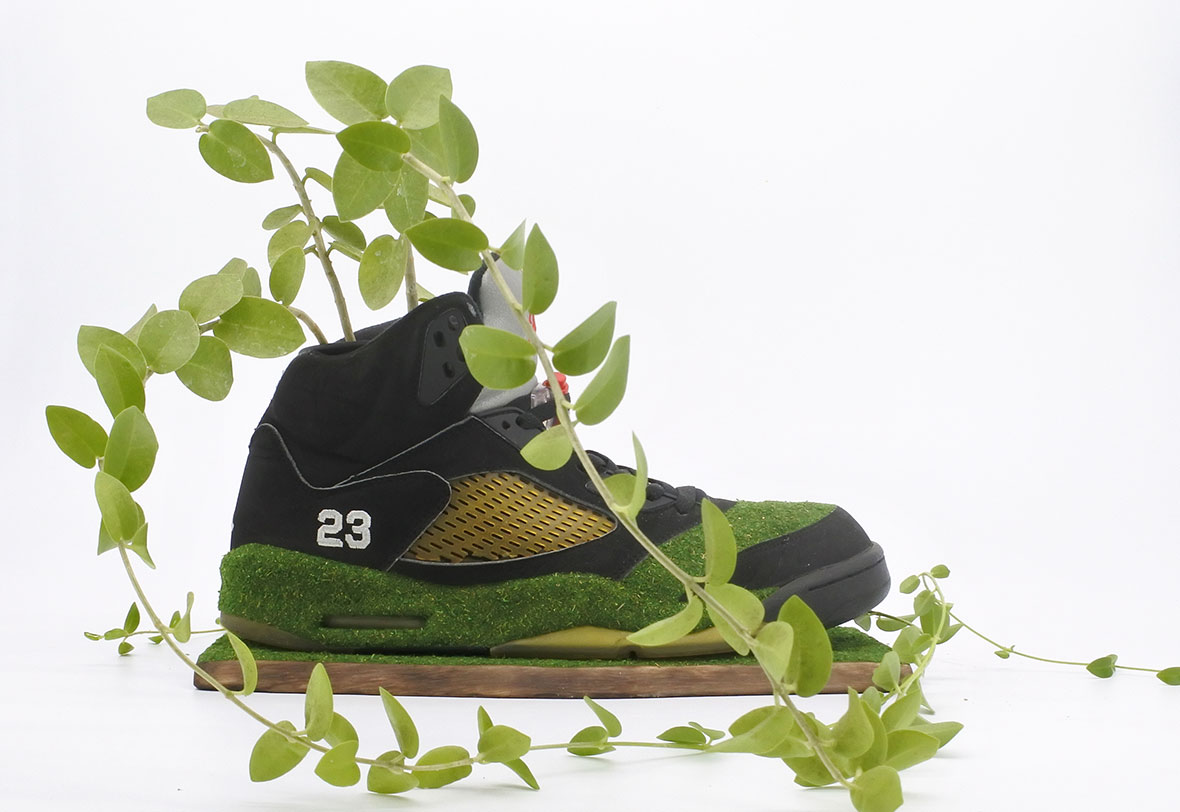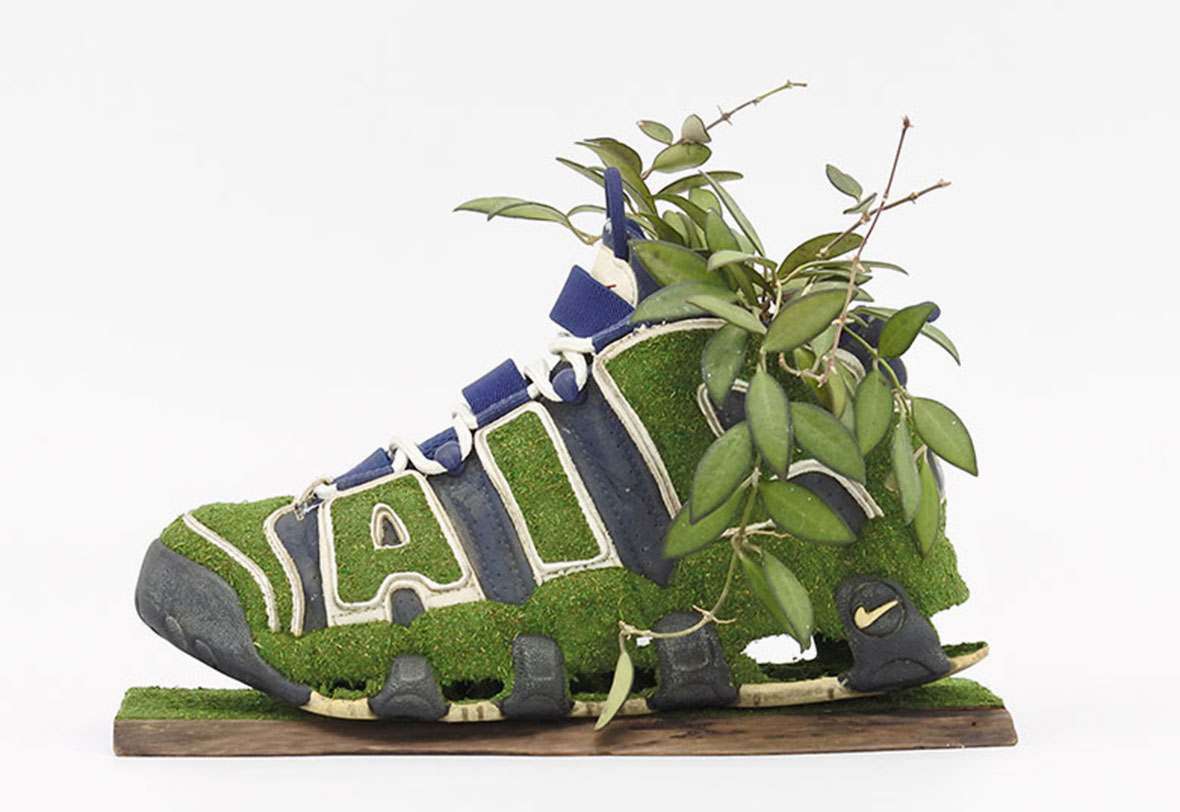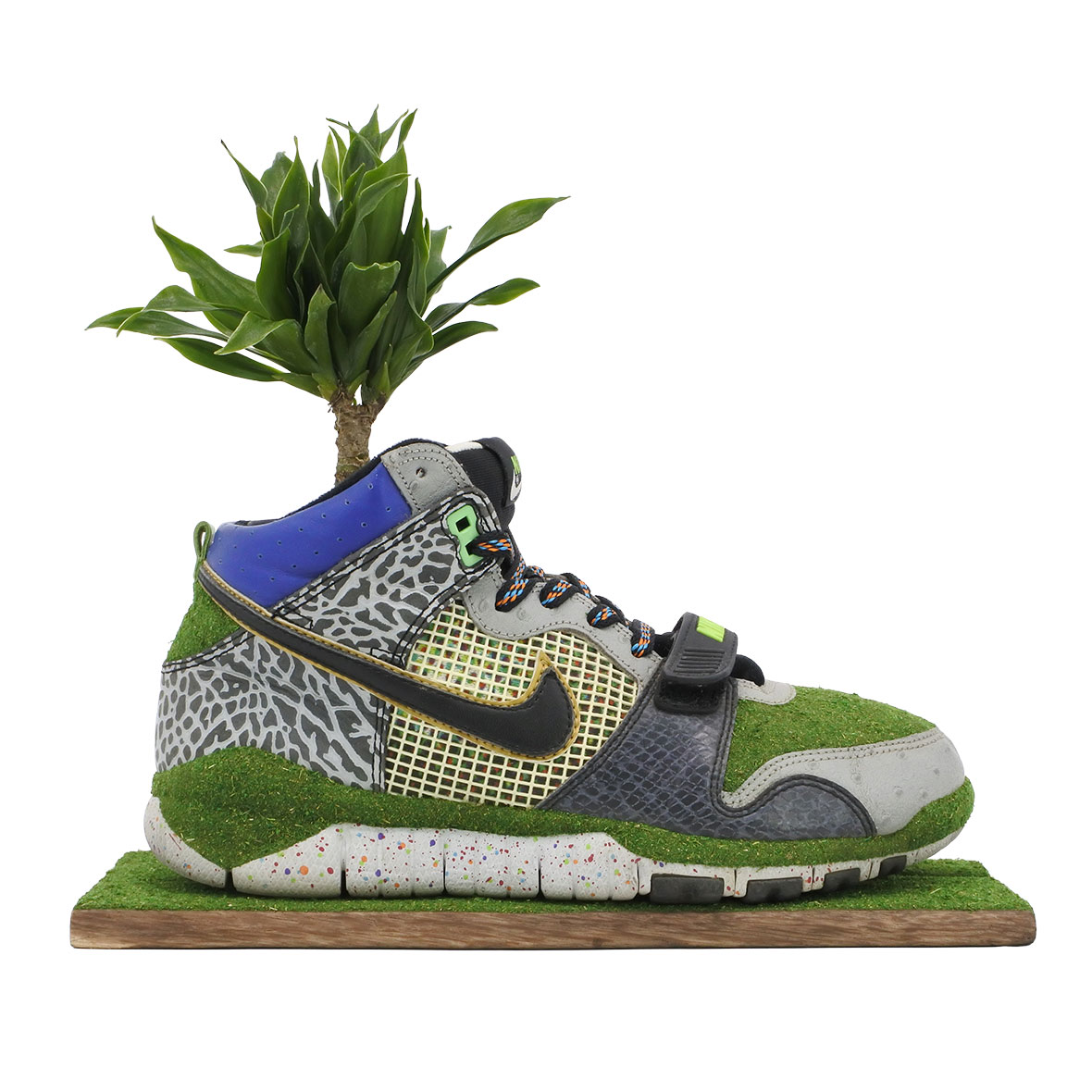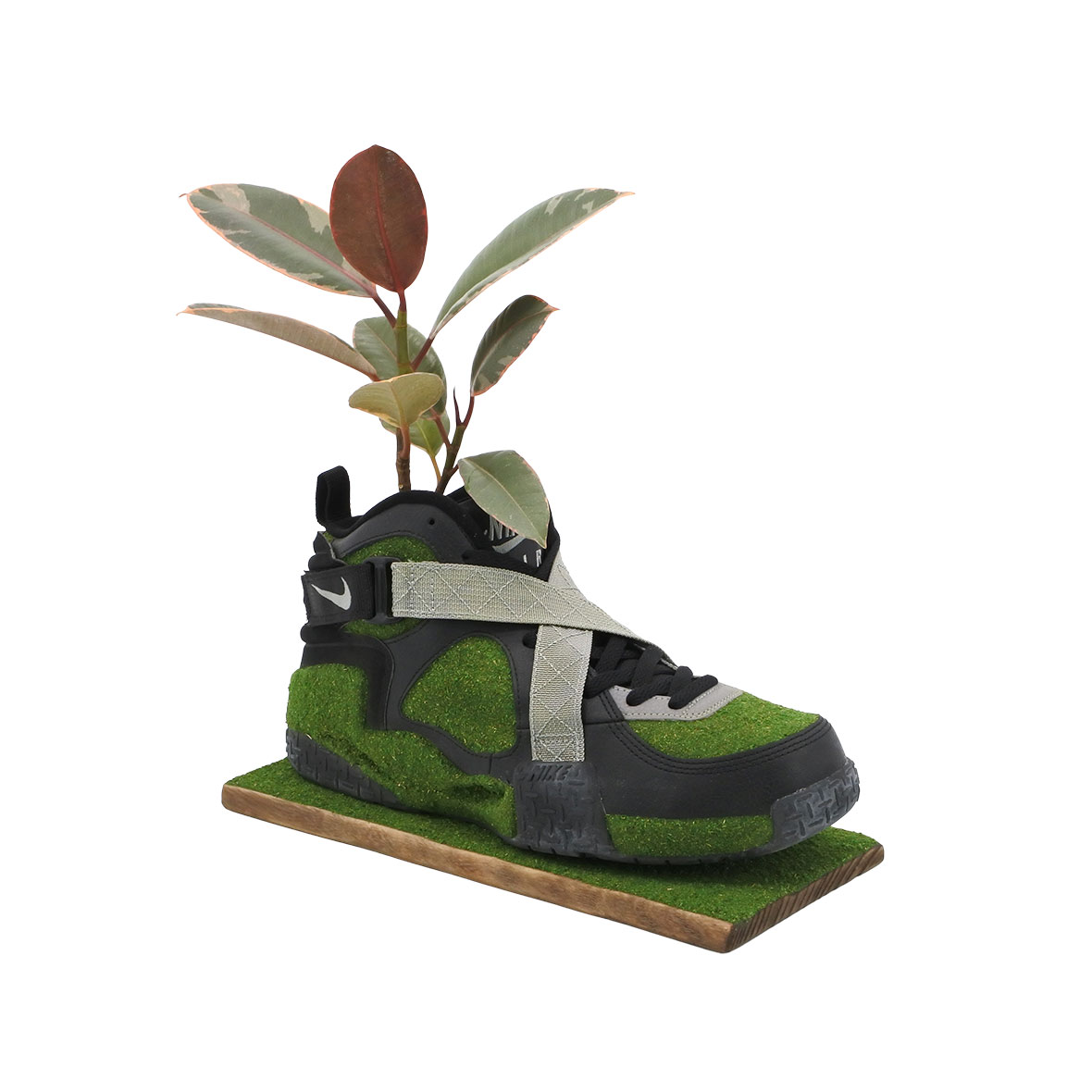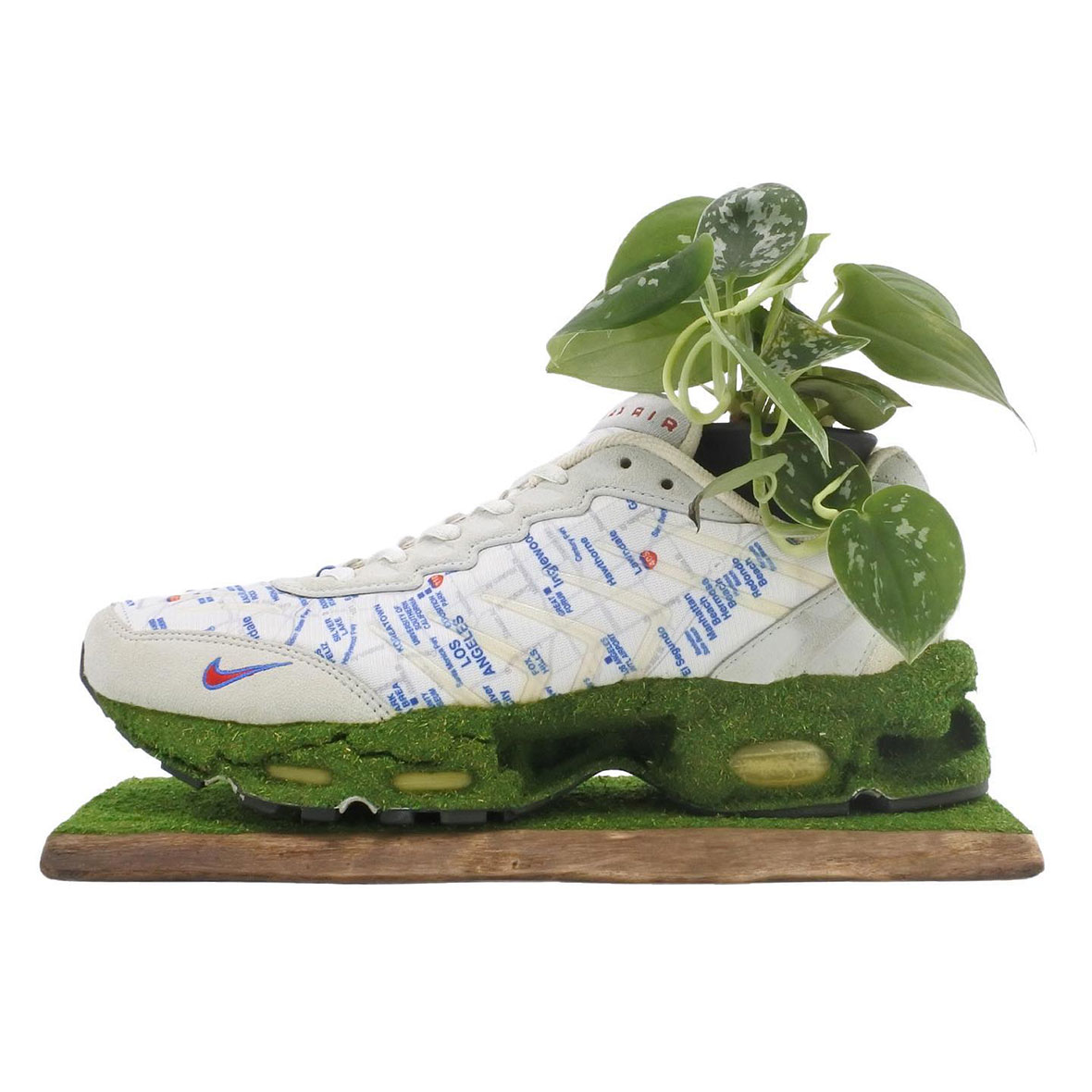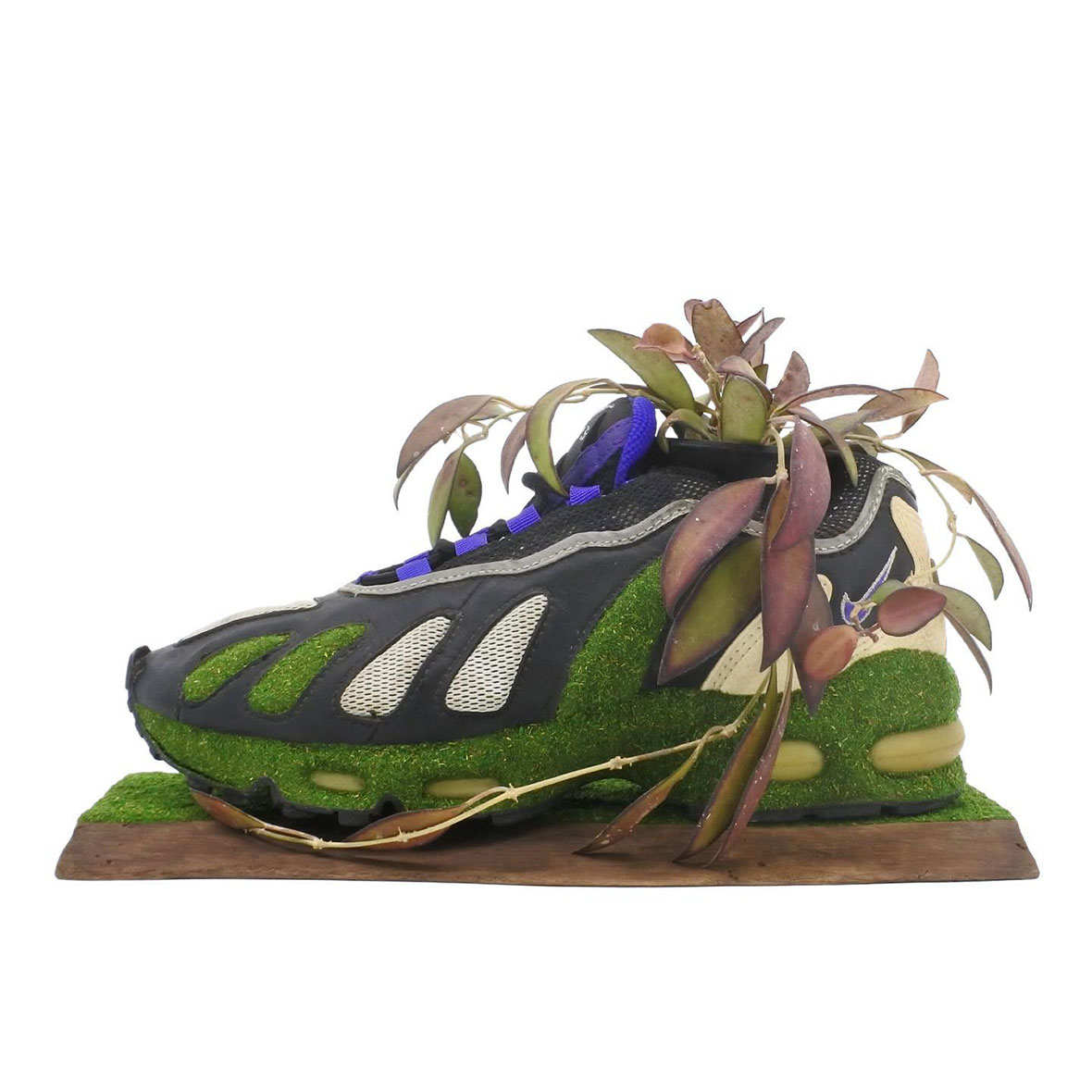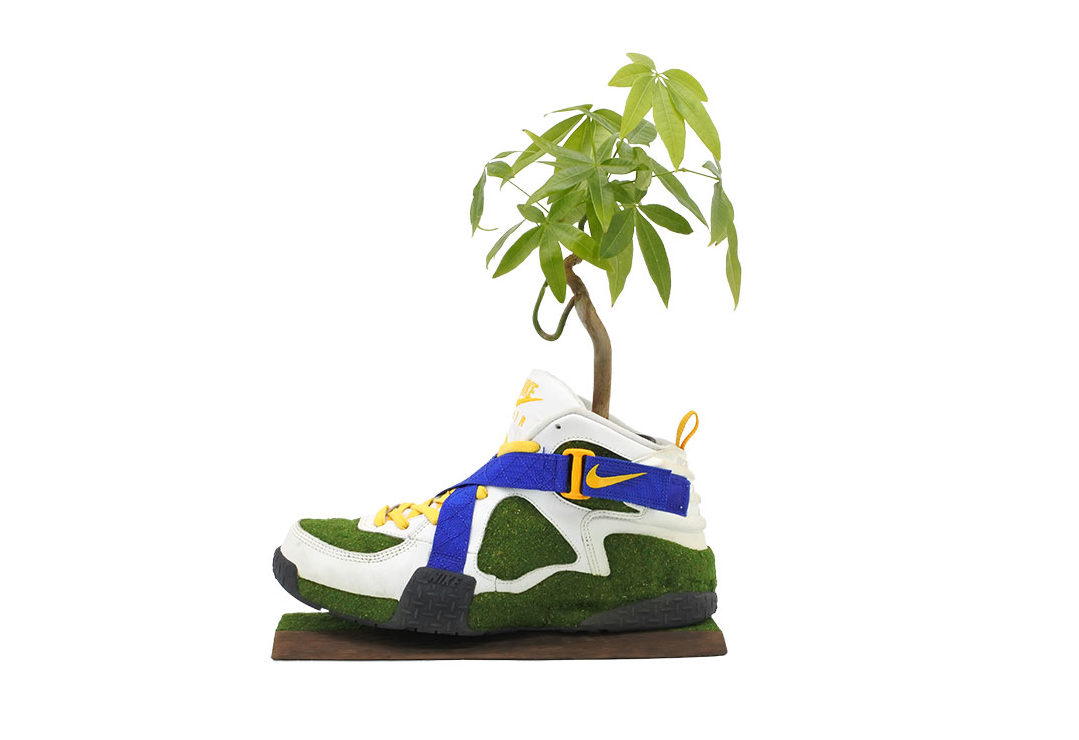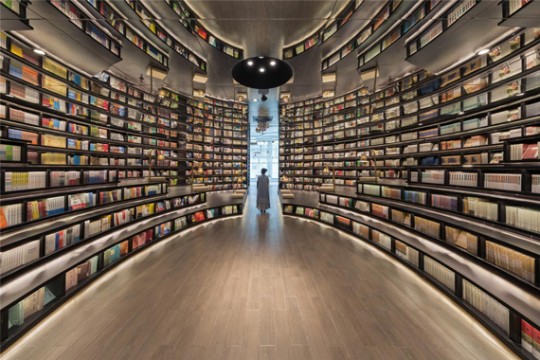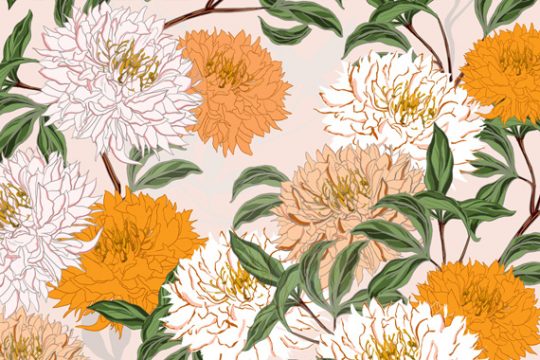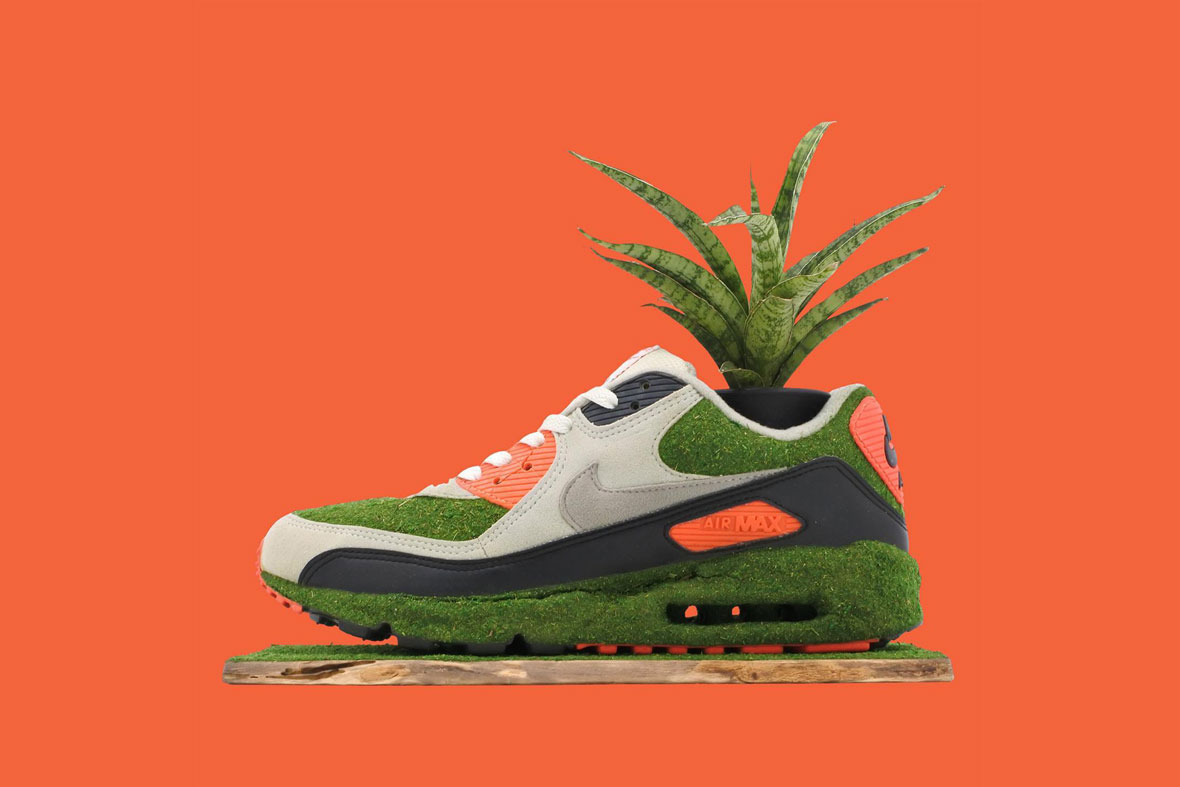
Kosuke Sugimot loves sneakers. And he loves plants. It was only natural that he’d find a way to combine these two passions. In a project titled Shoetree, he transforms used trainers into eco-art sculptures. For one piece, green moss wraps around the contours of a Nike Air More Uptempo, while a colorful vine plant seems to crawl out from within the sneaker. In another piece, a tropical houseplant extends skywards from an Air Jordan 5 Retro. With this project, Kosuke subverts sneaker culture’s affiliation with mindless consumption, renewing an appreciation for shoewear in a different light.
Kosuke Sugimot 喜欢球鞋和绿植。他结合这两种元素,打造了一个名为 Shoetree 的艺术项目,其旨在利用回收来的二手运动鞋,完成数件环保主题的雕塑作品。一幅作品中,耐克 Air More Uptempo 的球鞋表面被苔藓覆盖,植物枝叶从鞋里野蛮生长;另一幅作品里,热带植物化作飞人,从复刻版乔丹 5 代里一跃而出。这些作品打破了运动鞋文化与非理性消费之间的联系,也让人以另一种眼光看待球鞋。
The 37-year-old artist, born and raised in Tokyo, got his start at university studying graphic design, but he valued the opportunity to network and socialize more than he did his actual studies. “I tended to skip,” Sugimot laughs. He was working as a florist and a clothes maker when the idea of Shoetree clicked for him in 2016. He was walking around the city and noticed a deteriorating wall covered in moss and found it captivating. The way that nature reclaimed its space on a man-made structure was a sight of beauty. Although he doesn’t explicitly make any statements about the environment, it’s inherent in his work—it’s difficult not to think about recycling, waste, and the natural world when looking at one of his pieces.
这位如今 37 岁的艺术家在东京出生和长大,大学时修读平面设计。但比起课堂学习,他更看重社交。“我经常逃课,” Kosuke 笑着说道。2016 年,在从事花店和服装设计期间,突然间有了创作 Shoetree 系列的想法。那是一次在街上闲逛的经历,他偶然被一面长满青苔的墙壁深深吸引。他意识到,这是大自然在重新夺回一度被人类占据的空间,极具美感。虽然 Kosuke 没有明确地表达自己对环境问题的看法,但当你看到他的作品时,很难不联想到关于回收、浪费和大自然的话题。
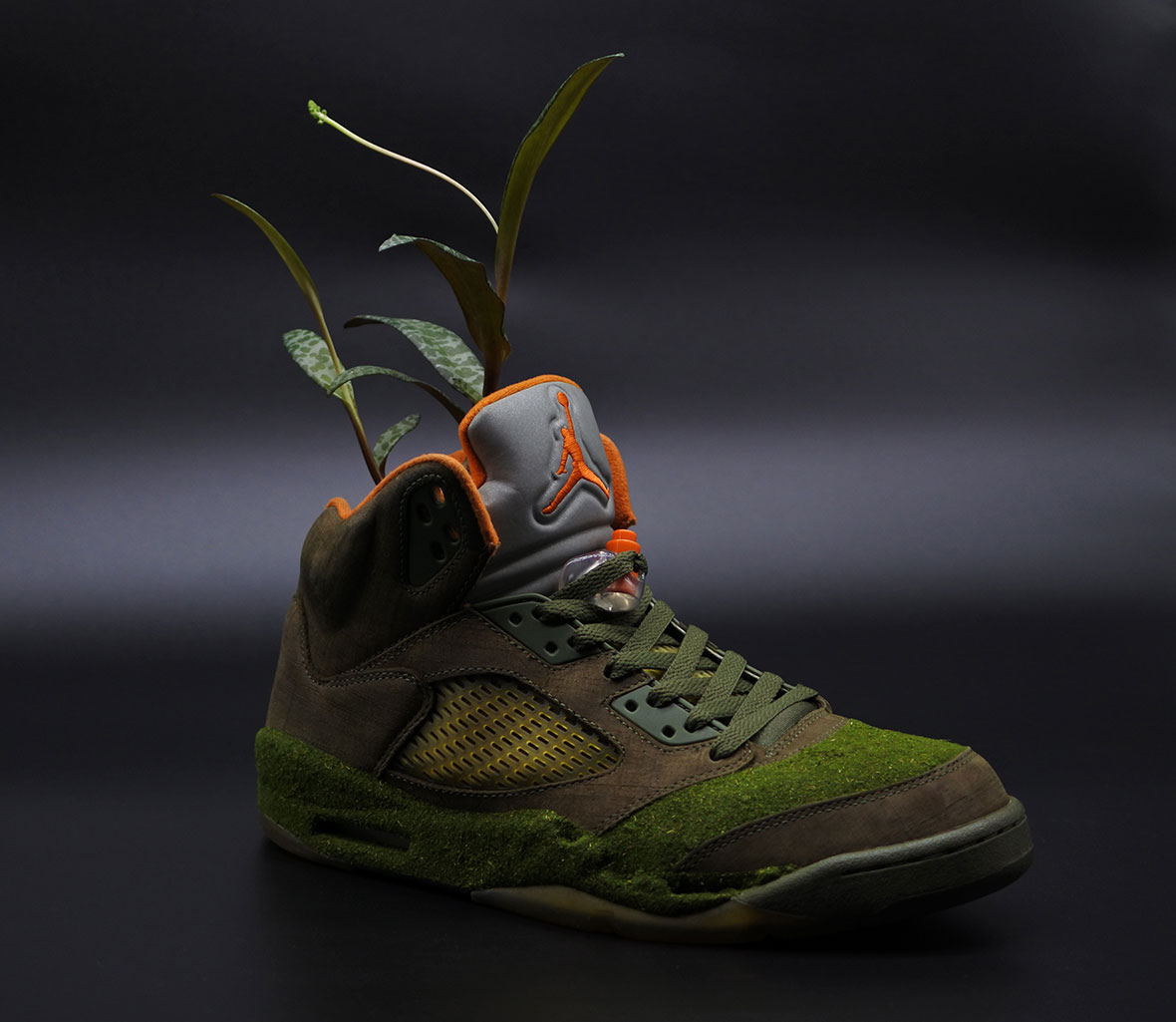
By 2017, Sugimot was able to turn Shoetree into a business, and he now works out of a tiny shop named Moku, which is tucked away on a tight Tokyo side street. It’s owned by another company that sells house plants and orchids, but he uses it as a studio and office. His sneaker plant pots and other plant works are on display and for sale there as well.
2017 年,Kosuke 成功将 Shoetree 商业化。现在,他在一家名为 Moku 的小店内工作。这家店藏匿于东京一条狭窄的小巷里,隶属于另一家专注室内植物和兰花的公司。也是在这里,他开设了自己的工作室,展示并售卖自己的运动鞋花盆和其他植物作品。
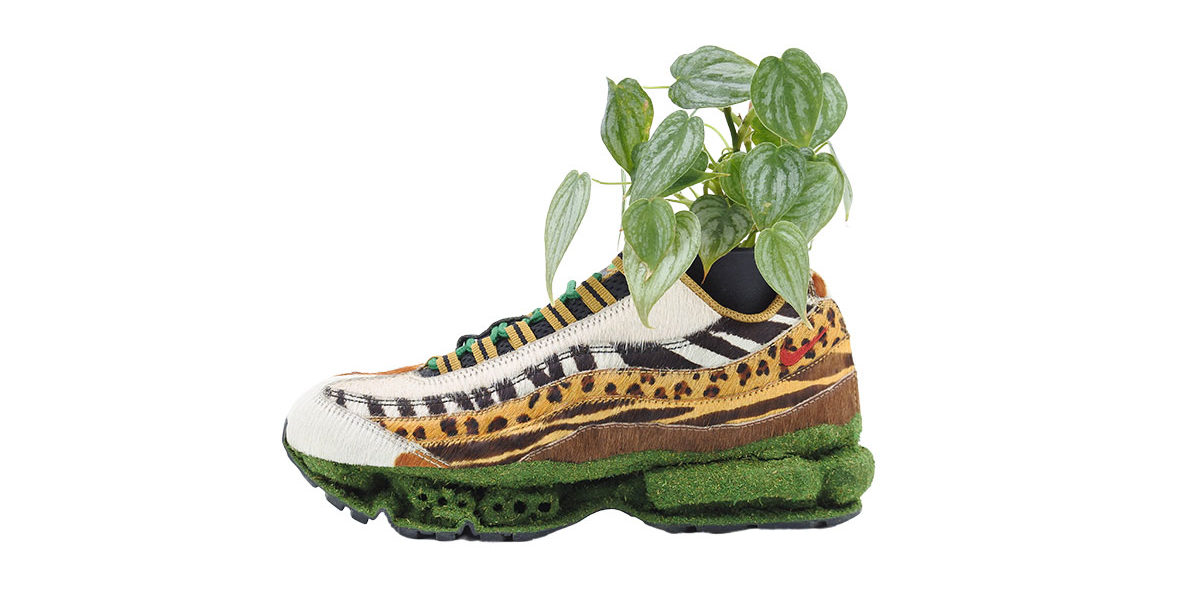
The majority of Sugimot’s sneakers are Nikes, but he occasionally uses other brands as well. “Nike is the best, it’s enough to use only Nike.” He says the brand is supportive of his work and they even held an event together in Shanghai a couple years ago, which he was honored to participate in. Most of his customers are sneakerheads, but more recently, his work has been capturing the attention of people without a prior interest in sneakers or plants.
For shoes, Sugimot works with a range of styles. One piece may feature earthy browns and dark, olive greens that blend seamlessly with plant and moss. But another can be the exact opposite, such as one with hologram panels contrasting sharply with the green adornments. But whichever he uses, the sneakers are always pristine and immaculately repaired.
大多数 Kosuke 二次创作的运动鞋都是耐克,“我超爱耐克的,对我来说,耐克球鞋无论从做工还是设计都是最好的,创作用耐克就够了,”他说。品牌方也很欣赏他的创作,几年前,耐克曾与他合作,在上海举办活动。他的大多数客户本身就是运动鞋发烧友,但最近,他的作品吸引了更多原本对球鞋或植物不太感兴趣的人。
他的作品风格多样。有的主打大地色调,以棕色和深橄榄绿,与植物和青苔无缝衔合;有的则以丰富的鞋面颜色,与绿色装饰相互映衬。但无论哪种风格,他都会对运动鞋进行完美修复,呈现其原貌。
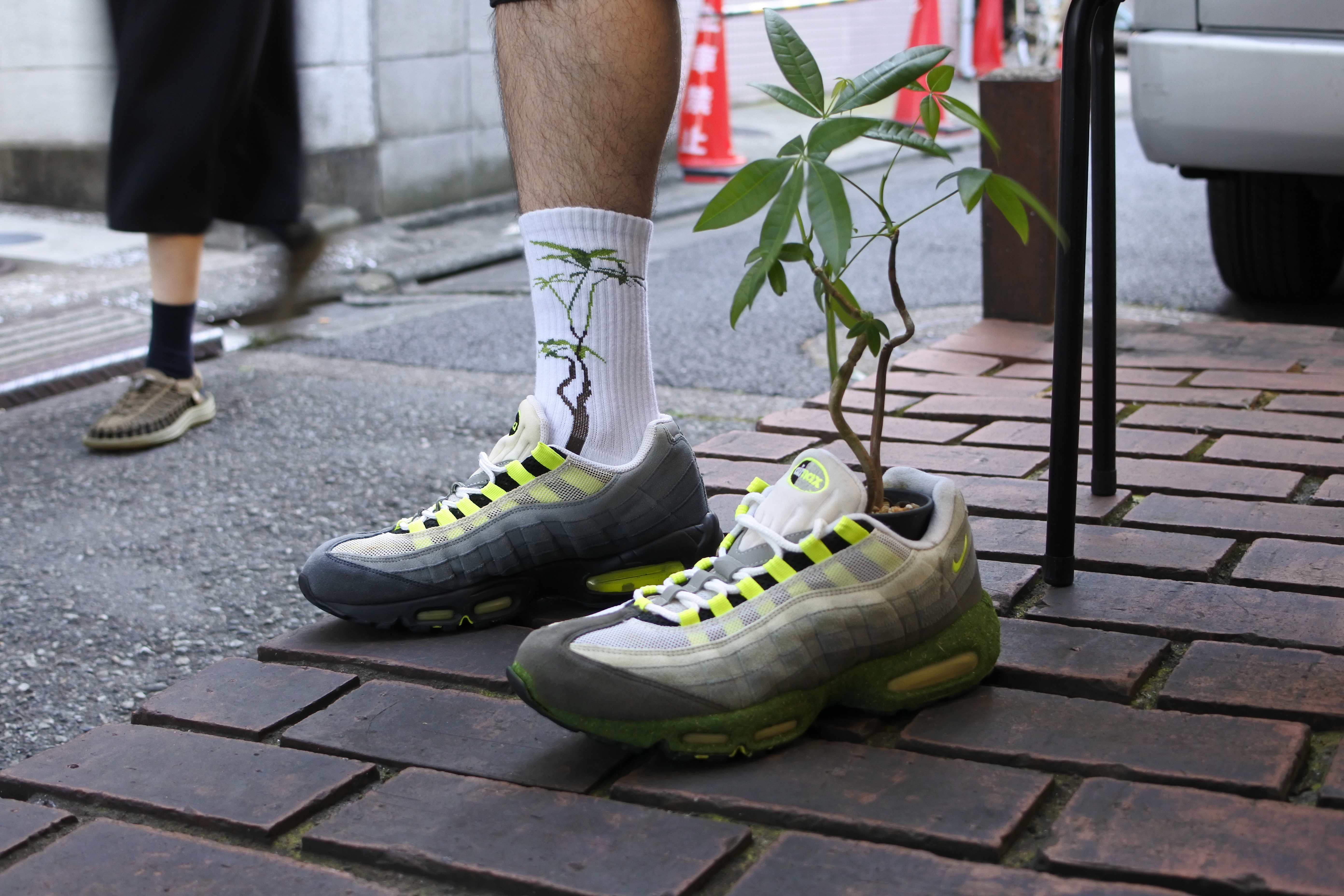
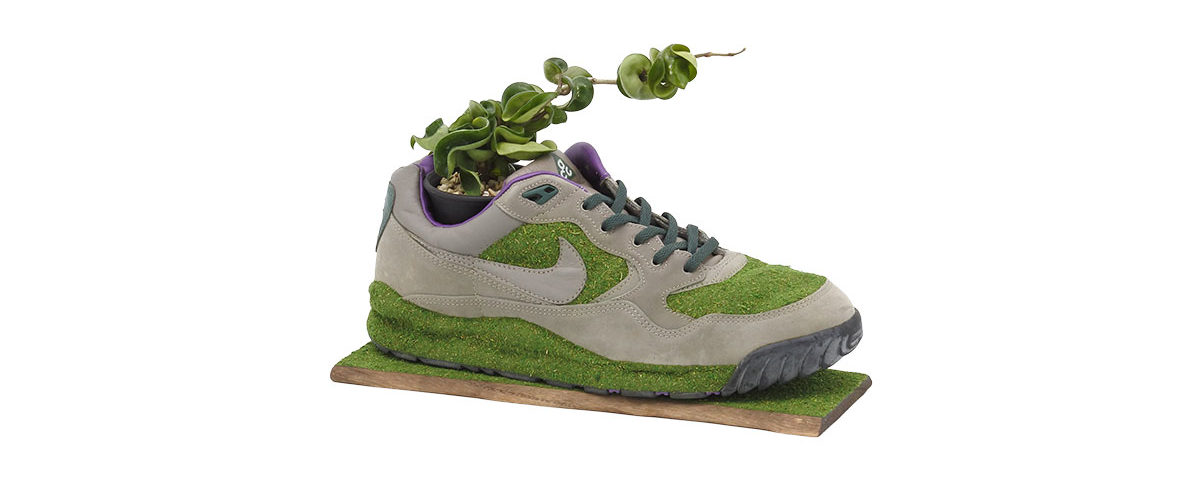
Sugimot first cleans and fixes the sneakers he intends on using. Once it’s restored, he pastes particulate dry moss along specific parts of its exterior. In order to keep the moss from falling apart, he layers it on twice. The two-fold process is more about protection than decoration. Since the moss is dried, it doesn’t grow but can fade from strong ultraviolet rays if not cared for properly.
创作过程中,Kosuke 首先要对球鞋进行清洁和修复,然后沿着鞋面仔细粘贴青苔。为了防止掉落,他通常会叠两层青苔。所用的青苔都经过干燥处理,因此不必担心青苔的肆意蔓延;但如果维护不当,这些青苔装饰可能会在紫外线下褪色。在他看来,制作的过程中,维护的工作量要比装饰大的多。
For the potted plants that are added as the final touch, he prefers vine plants that are easily accessible, such as pachira, ficus microcarpa, and dracena plants. Sugimot believes that the mundanity of his plant choices makes them more accessible. Pivoting from the sense of rarity or exclusivity that’s a big part of sneaker culture, he wants his work to feel within reach of ordinary people. He wants it to be available for as many interested collectors as possible and to reach audiences from all walks of life.
对于在球鞋里栽种的植物,他偏爱生活中常见的藤蔓植物,例如发财树、细叶榕和龙血树。Kosuke 认为选择这些植物,更易于与大众产生共鸣。他希望一改运动鞋文化所追求的“物以稀为贵”的风气,让球鞋平易近人,这样会有越来越多的人想把它们带回家收藏起来,吸引更多来自各行各业的人。
Like our stories? Follow us on Facebook and Instagram.
Website: www.shoetree.tokyo
Instagram: @shoetree_2016
Contributor: Mike Steyels
Chinese Translation: Olivia Li

